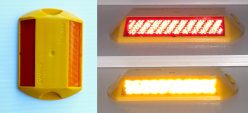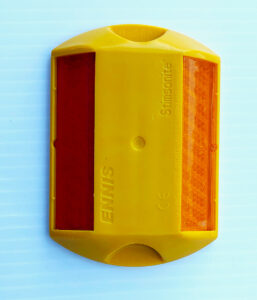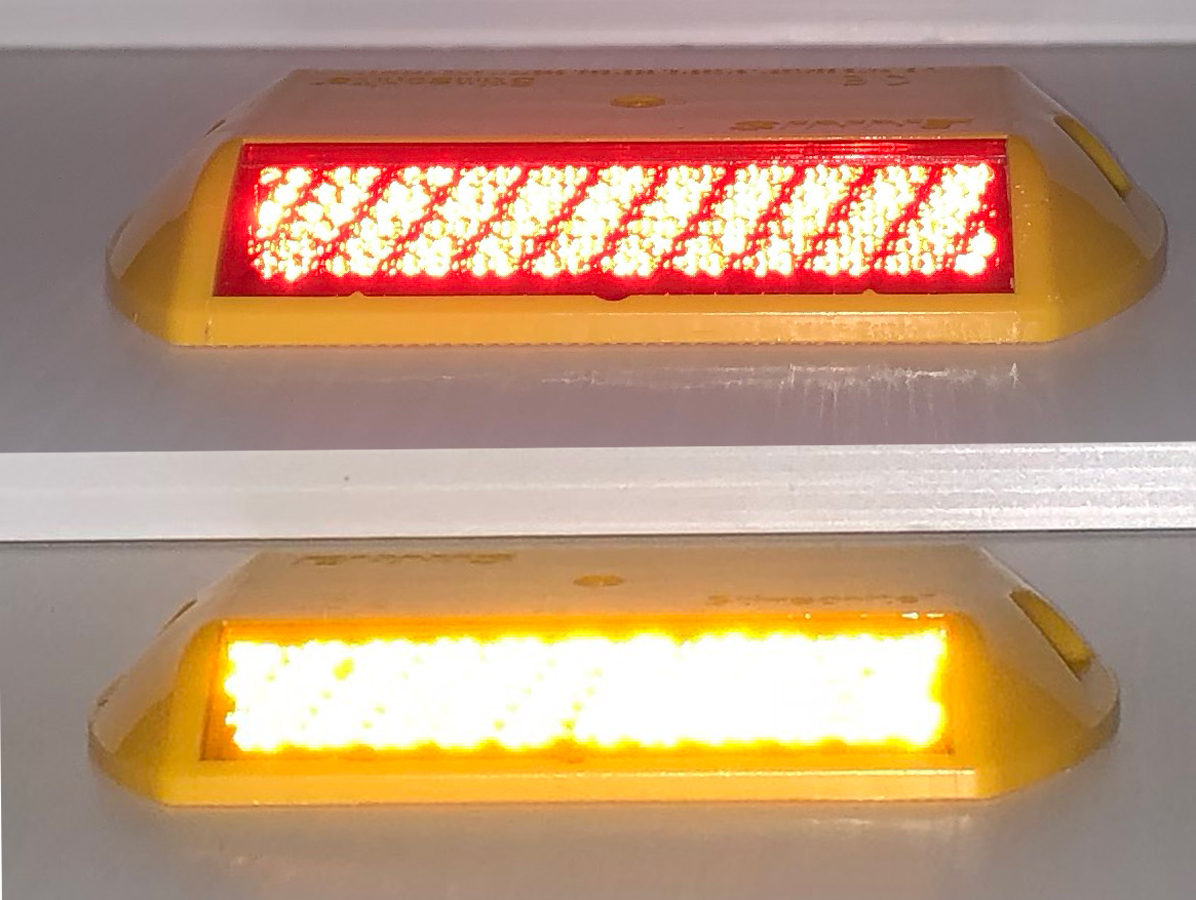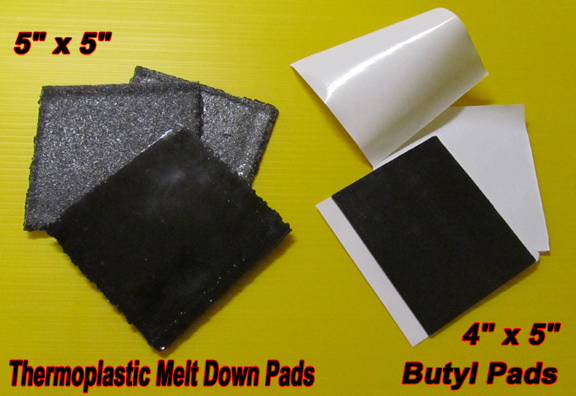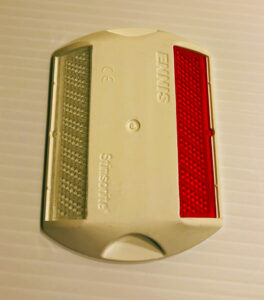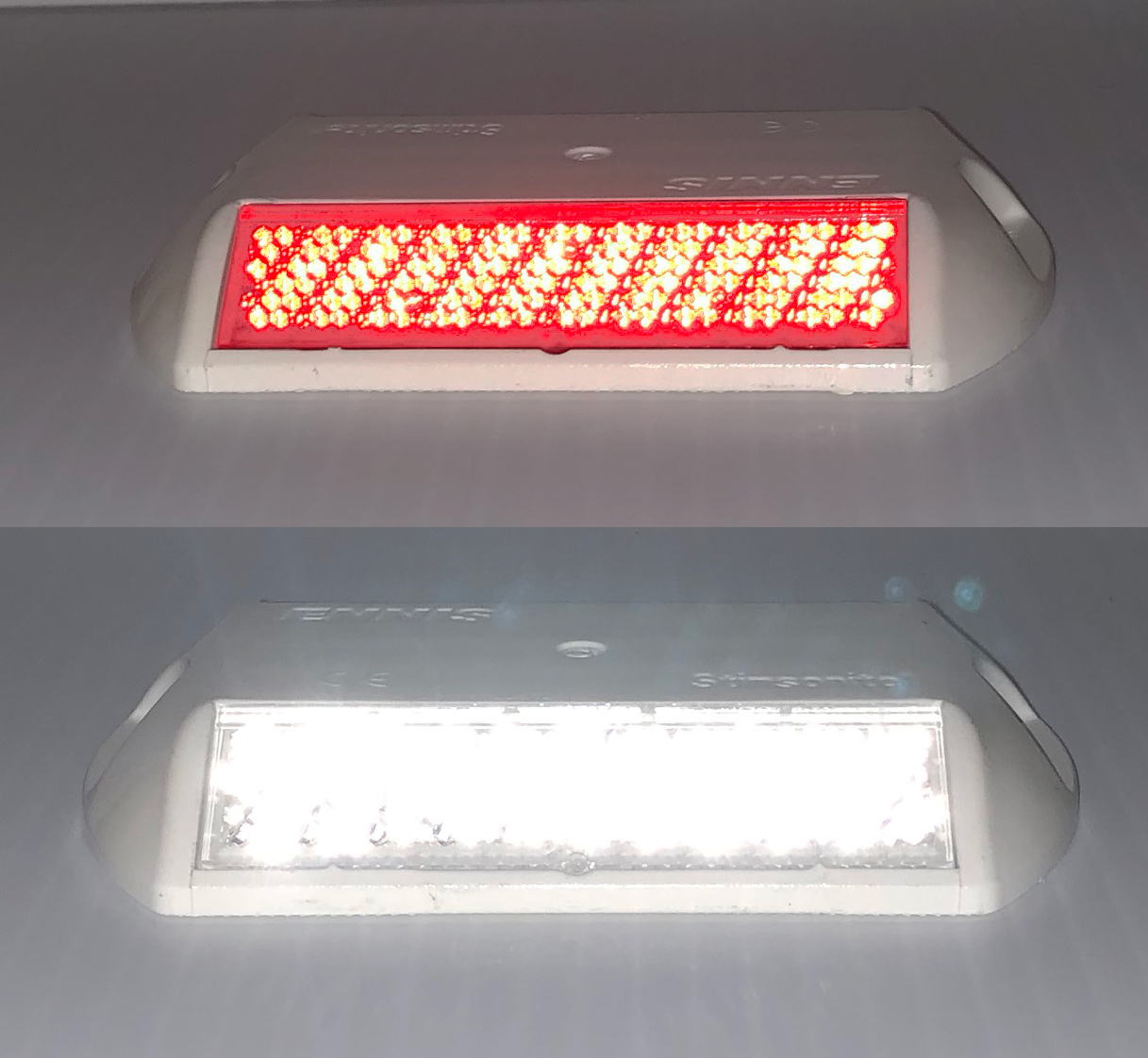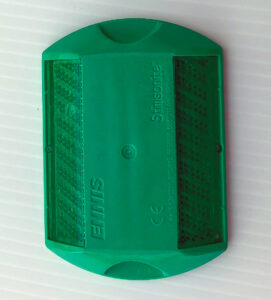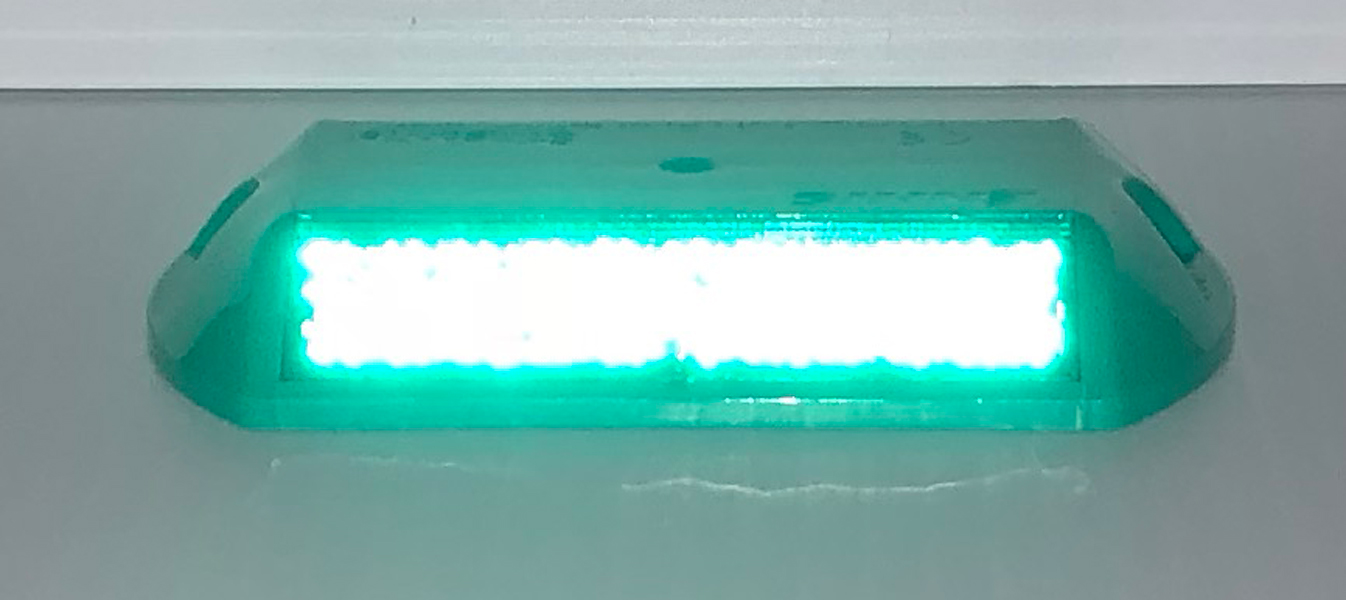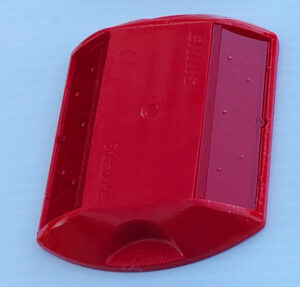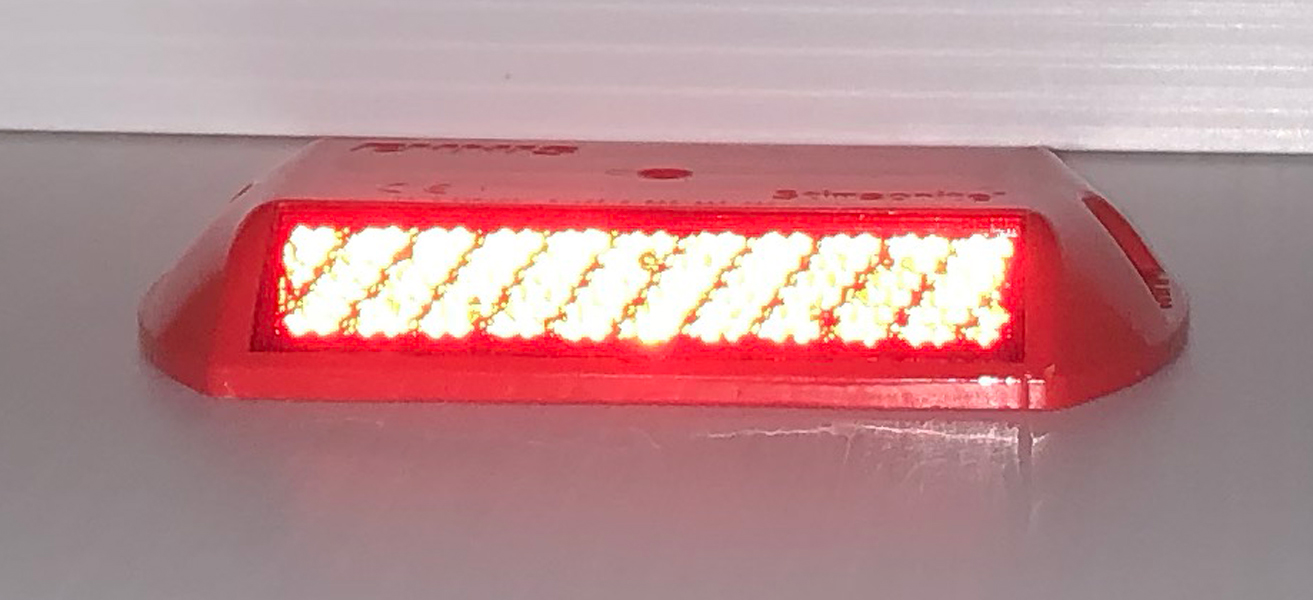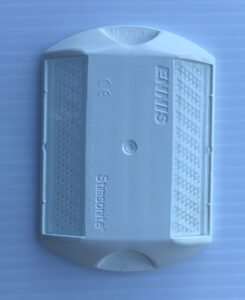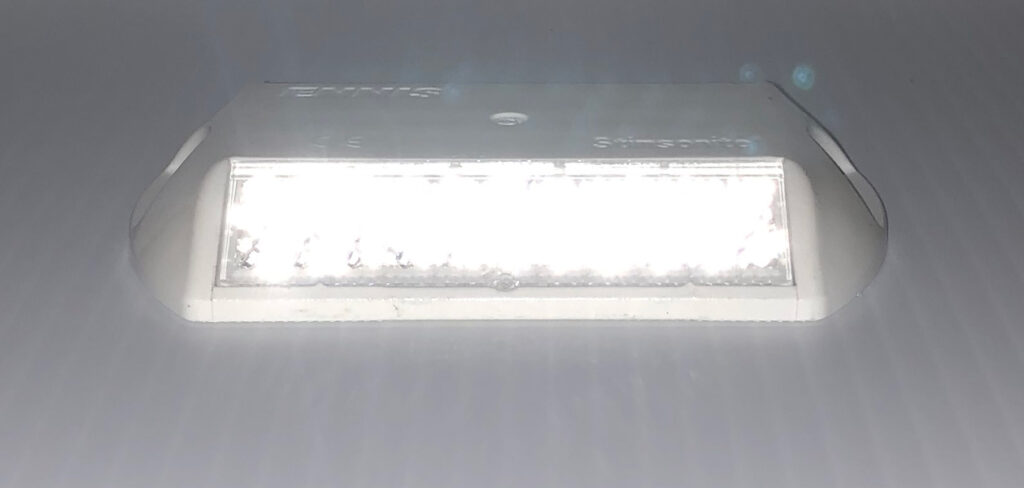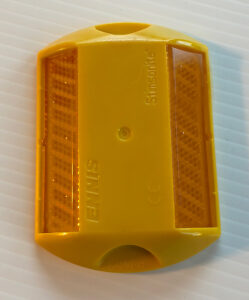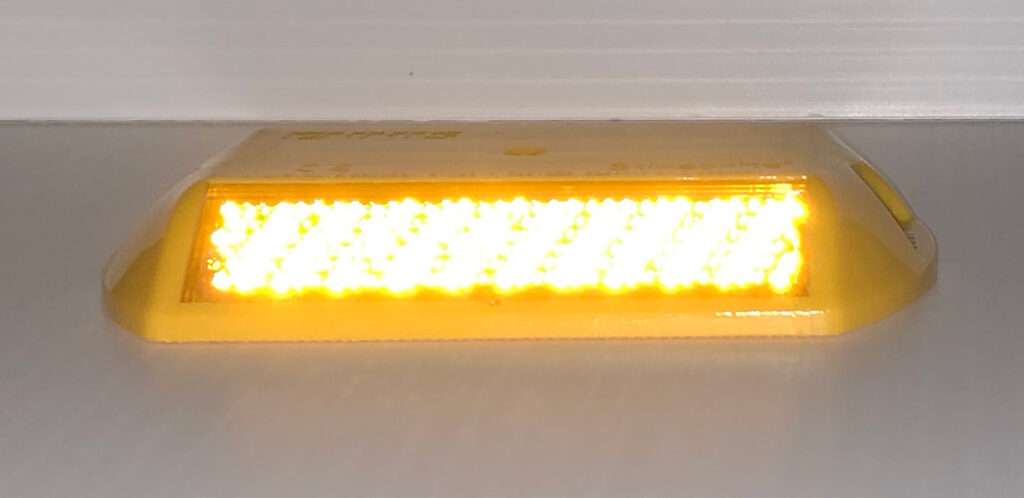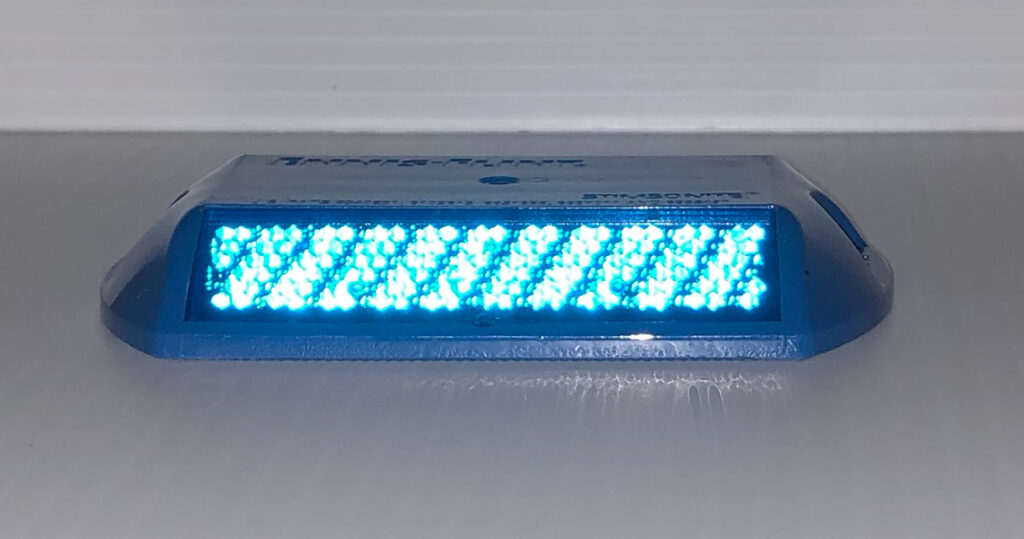Select the marker color and quantity below. Our reflective road markers are available with or without a melt down adhesive pad. Contact us with any questions.
Posts
Yellow and Red C80 Raised Reflective Road Markers / Reflectors
Click Here to go to our product ordering page.
Our Yellow/Red Model C80 markers from Stimsonite combine the durability of an ABS high strength shell and advanced optics to create one of the toughest and brightest Raised Pavement Markers in the industry.
The Yellow/Red C80 Raised Pavement / Road Markers on this page are “two way” and are reflective from both directions. They are used to show yellow to cars going the correct way on a one way street and red to cars going the wrong way. The markers measure 4″ x 4″ and are slightly less than 3/4″ tall. In high-intensity traffic conditions, abrasion resistance is crucial to extending the service life of the marker. Our C80 markers include a long-life abrasion resistant coating to enhance the retained reflectivity of the marker. This provides the safest delineation to drivers in critical wet-night conditions
The markers can be applied to asphalt or cement road surfaces using our Melt Down Thermoplastic Pads. You can also purchase epoxy locally and apply them. For wooden surfaces like railroad ties you can drill through the middle of the marker and screw them down. For large application areas you can also use hot tar.
We sell the Yellow and Red C80 Markers in 2 configurations. Marker only, and marker with melt down thermoplastic pad. (See picture at bottom of page)
Our melt down 5 x 5 thermoplastic pads are more permanent. To install just heat the surface, lay down the pad, continue heating until the pad is melted and then lightly press the marker into the center of the thermoplastic and let cool.
The markers can be applied to asphalt or cement road surfaces using our Melt Down Thermoplastic Pads. You can also purchase epoxy locally and apply them. For wooden surfaces like railroad ties you can drill through the middle of the marker and screw them down. For large application areas you can also use hot tar.
We sell the Yellow and Red C80 Markers in 2 configurations. Marker only and Marker with melt down thermoplastic pad. (See picture at bottom of page)
White and Red C80 Raised Reflective Road Markers / Reflectors
Click Here to go to our product ordering page.
Our White/Red Model C80 markers from Stimsonite combine the durability of an ABS high strength shell and advanced optics to create one of the toughest and brightest Raised Pavement Markers in the industry.
The White/Red C80 Raised Pavement / Road Markers on this page are “two way” and are reflective from both directions. They are used to show white to cars going the correct way on a one way street and red to cars going the wrong way. The markers measure 4″ x 4″ and are slightly less than 3/4″ tall. In high-intensity traffic conditions, abrasion resistance is crucial to extending the service life of the marker. Our C80 markers include a long-life abrasion resistant coating to enhance
The markers can be applied to asphalt or cement road surfaces using our Melt Down Thermoplastic Pads. You can also purchase epoxy locally and apply them. For wooden surfaces like railroad ties you can drill through the middle of the marker and screw them down. For large application areas you can also use hot tar.
We sell the White and Red C80 Markers in 2 configurations. Marker only, and marker with melt down thermoplastic pad. (See picture at bottom of page)
Our melt down 5 x 5 thermoplastic pads are more permanent. To install just heat the surface, lay down the pad, continue heating until the pad is melted and then lightly press the marker into the center of the thermoplastic and let cool.
Green C80 Raised Reflective Road Markers / Reflectors
Click Here to go to our product ordering page.
Our Green Model C80 markers from Stimsonite combine the durability of an ABS high strength shell and advanced optics to create one of the toughest and brightest Raised Pavement Markers in the industry.
Green markers normally designate that an area is “OK” for traffic. The Green C80 Raised Pavement / Road Markers on this page are “two way” and are reflective from both directions. The markers measure 4″ x 4″ and are slightly less than 3/4″ tall. In high traffic areas, abrasion resistance is crucial to extending the service life of the marker. Our C80 markers include a long-life abrasion resistant coating to extend the reflectivity of the marker over time. This provides the safest delineation to drivers in critical wet-night conditions.
The markers can be applied to asphalt or cement road surfaces using our Melt Down Thermoplastic Pads. You can also purchase epoxy locally and apply them. For wooden surfaces like railroad ties you can drill through the middle of the marker and screw them down. For large application areas you can also use hot tar.
We sell the Green C80 Markers in 2 configurations. Marker only, and marker with melt down thermoplastic pad. (See picture at bottom of page)
Our melt down 5 x 5 thermoplastic pads are more permanent. To install just heat the surface, lay down the pad, continue heating until the pad is melted and then lightly press the marker into the center of the thermoplastic and let cool.
Red C80 Raised Reflective Pavement Markers / Reflectors
Click Here to go to our product ordering page.
Our Red Model C80 markers from Stimsonite combine the durability of an ABS high strength shell and advanced optics to create one of the toughest and brightest Raised Pavement Markers in the industry.
Red markers are typically used to mark areas where cars or vehicles are prohibited. The Red C80 Raised Pavement / Road Markers on this page are “two way” and are reflective from both directions. The markers measure 4″ x 4″ and are slightly less than 3/4″ tall. In high-intensity traffic conditions, abrasion resistance is crucial to extending the service life of the marker. Our C80 markers include a long-life abrasion resistant coating to enhance the retained reflectivity of the marker. This provides the safest delineation to drivers in critical wet-night conditions.
The markers can be applied to asphalt or cement road surfaces using our Melt Down Thermoplastic Pads. You can also purchase epoxy locally and apply them. For wooden surfaces like railroad ties you can drill through the middle of the marker and screw them down. For large application areas you can also use hot tar.
We sell the Red C80 Markers in 2 configurations. Marker only, and marker with melt down thermoplastic pad. (See picture at bottom of page)
Our melt down 5 x 5 thermoplastic pads are more permanent. To install just heat the surface, lay down the pad, continue heating until the pad is melted and then lightly press the marker into the center of the thermoplastic and let cool.
White C80 Raised Reflective Road Markers / Reflectors
Click Here to go to our product ordering page.
Our White Model C80 markers from Stimsonite combine the durability of an ABS high strength shell and advanced optics to create one of the toughest and brightest Raised Pavement Markers in the industry.
The White C80 Raised Pavement / Road Markers on this page are “two way” and are reflective from both directions. The markers measure 4″ x 4″ and are slightly less than 3/4″ tall. In high-intensity traffic conditions, abrasion resistance is crucial to extending the service life of the marker. Our C80 markers include a long-life abrasion resistant coating to enhance the retained reflectivity of the marker. This provides the safest delineation to drivers in critical wet-night conditions.
The markers can be applied to asphalt or cement road surfaces using our Melt Down Thermoplastic Pads. You can also purchase epoxy locally and apply them. For wooden surfaces like railroad ties you can drill through the middle of the marker and screw them down. For large application areas you can also use hot tar.
We sell the White C80 Markers in 2 configurations. Marker only, and marker with melt down thermoplastic pad. (See picture at bottom of page)
Our melt down 5 x 5 thermoplastic pads are more permanent. To install just heat the surface, lay down the pad, continue heating until the pad is melted and then lightly press the marker into the center of the thermoplastic and let cool.
Yellow C80 Raised Reflective Road Markers / Reflectors
Click Here to go to our product ordering page.
Our Yellow Model C80 markers from Stimsonite combine the durability of an ABS high strength shell and advanced optics to create one of the toughest and brightest Raised Pavement Markers in the industry.
The Yellow C80 Raised Pavement / Road Markers on this page are “two way” and are reflective from both directions. The markers measure 4″ x 4″ and are slightly less than 3/4″ tall. In high-intensity traffic conditions, abrasion resistance is crucial to extending the service life of the marker. Our C80 markers include a long-life abrasion resistant coating to enhance the retained reflectivity of the marker. This provides the safest delineation to drivers in critical wet-night conditions.
The markers can be applied to asphalt or cement road surfaces using our Melt Down Thermoplastic Pads. You can also purchase epoxy locally and apply them. For wooden surfaces like railroad ties you can drill through the middle of the marker and screw them down. For large application areas you can also use hot tar.
We sell the Yellow C80 Markers in 2 configurations. Marker only, and marker with melt down thermoplastic pad. (See picture at bottom of page)
Our melt down 5 x 5 thermoplastic pads are more permanent. To install just heat the surface, lay down the pad, continue heating until the pad is melted and then lightly press the marker into the center of the thermoplastic and let cool.
Blue C80 Raised Reflective Road Markers / Reflectors – Fire Hydrant
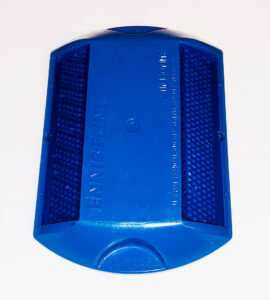 Click Here to go to our product ordering page.
Click Here to go to our product ordering page.
Our Blue Model C80 markers from Stimsonite combine the durability of an ABS high strength shell and advanced optics to create one of the toughest and brightest Raised Pavement Markers in the industry. Blue markers are typically used to mark fire hydrants. The Blue C80 Raised Pavement / Road Markers on this page are “two way” and are reflective from both directions. The markers measure 4″ x 4″ and are slightly less than 3/4″ tall. In high-intensity traffic conditions, abrasion resistance is crucial to extending the service life of the marker. Our C80 markers include a long-life abrasion resistant coating to enhance the retained reflectivity of the marker. This provides the safest delineation to drivers in critical wet-night conditions.
The markers can be applied to asphalt or cement road surfaces using our Melt Down Thermoplastic Pads. You can also purchase epoxy locally and apply them. For wooden surfaces like railroad ties you can drill through the middle of the marker and screw them down. For large application areas you can also use hot tar.
We sell the Blue C80 Markers in 2 configurations. Marker only, and marker with melt down thermoplastic pad. (See picture at bottom of page)
Our melt down 5 x 5 thermoplastic pads are more permanent. To install just heat the surface, lay down the pad, continue heating until the pad is melted and then lightly press the marker into the center of the thermoplastic and let cool.
How to Install Raised Reflective Pavement Road Markers
Raised pavement markers are used all over the world to provide safety and direction to drivers that can be both seen and felt day and night. When it comes to installation, the number one goal is that the marker stay in place. To accomplish this goal, proper installation methods should be followed. The method you use will depend on how much traffic will be going over the markers, the type and condition of the pavement, and whether the application will be permanent or temporary.
Temporary or Low Traffic Applications (Butyl Pads)
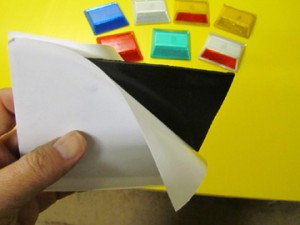 Quite often, raised pavement markers are placed in areas that will receive either very low traffic or standard traffic for a short period of time. For example, in construction areas, markers will be put down and then later pulled back up. For applications like shopping cart return areas, traffic seldom affects the markers. Blue markers, placed out of the flow of traffic are also not subject to heavy traffic.
Quite often, raised pavement markers are placed in areas that will receive either very low traffic or standard traffic for a short period of time. For example, in construction areas, markers will be put down and then later pulled back up. For applications like shopping cart return areas, traffic seldom affects the markers. Blue markers, placed out of the flow of traffic are also not subject to heavy traffic.
In situations like these, a simple application method using double sided butyl pads can be used to apply the markers. Butyl is basically a sticky tar pad protected on both sides by removable wax paper. Butyl pads stay soft and pliable throughout their life thus making it possible to pry a marker off of the pad if necessary. The advantage of butyl pads is a quick application. A marker can be applied in just seconds using the peel and stick butyl pads. To apply markers using a butyl pad you simply peel the paper off of one side, press the pad into the road, peel the paper off the top and then press the marker into the butyl. Longevity depends entirely on traffic.
Melt Down or Torch Down Thermoplastic Pads
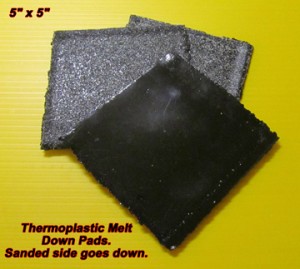 For more permanent applications a thermoplastic pad can be used. Thermoplastic is a meltable material that becomes liquid when heated to about 300 degrees. It forms a bond with both the road surface and the road marker. The thermoplastic pads that we sell are sanded on one side so that they do not stick to each other when shipped. To apply markers using the thermoplastic pads simply brush off any loose sand from the pad, heat the pavement to about 300 degrees, lay the pad on the hot surface sanded side down and continue to heat until the pad is molten. Then just lay your marker in the center of the pad and press gently. The thermoplastic will cool quickly and form a bond with the road and marker. At this point the marker is ready for traffic.
For more permanent applications a thermoplastic pad can be used. Thermoplastic is a meltable material that becomes liquid when heated to about 300 degrees. It forms a bond with both the road surface and the road marker. The thermoplastic pads that we sell are sanded on one side so that they do not stick to each other when shipped. To apply markers using the thermoplastic pads simply brush off any loose sand from the pad, heat the pavement to about 300 degrees, lay the pad on the hot surface sanded side down and continue to heat until the pad is molten. Then just lay your marker in the center of the pad and press gently. The thermoplastic will cool quickly and form a bond with the road and marker. At this point the marker is ready for traffic.
Hot Tar (Bitumen)
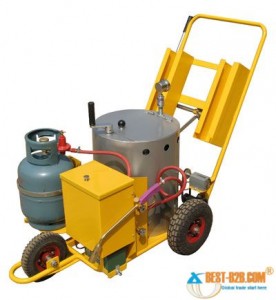 A common method of apply markers in quantity is to use hot tar or bitumen. This is done by melting a block of bitumen or tar in a melter and then dispensing some onto the pavement and placing a marker in the hot tar until it cools. This method is often used when large numbers of markers need to be applied at one time. The melter is mobile and the installer simply pours the tar onto the surface, lays down a marker and goes on to the next one. The results using this method will be similar to using a melt down thermoplastic pad only quicker.
A common method of apply markers in quantity is to use hot tar or bitumen. This is done by melting a block of bitumen or tar in a melter and then dispensing some onto the pavement and placing a marker in the hot tar until it cools. This method is often used when large numbers of markers need to be applied at one time. The melter is mobile and the installer simply pours the tar onto the surface, lays down a marker and goes on to the next one. The results using this method will be similar to using a melt down thermoplastic pad only quicker.
Epoxy (two part)
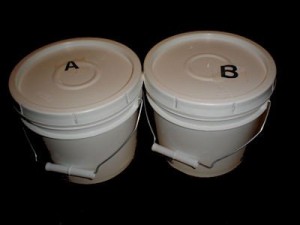 Epoxy is a very effective way of applying the markers to asphalt or cement. Epoxy is one of the few materials that will effectively bond to cement. There is more labor involved with using epoxy since the two parts must first be mixed. Also, after being mixed you have about 15 minutes to use the batch before it hardens. This creates a challenge to the installer. Also, traffic must be kept of the markers until the epoxy has properly cured.
Epoxy is a very effective way of applying the markers to asphalt or cement. Epoxy is one of the few materials that will effectively bond to cement. There is more labor involved with using epoxy since the two parts must first be mixed. Also, after being mixed you have about 15 minutes to use the batch before it hardens. This creates a challenge to the installer. Also, traffic must be kept of the markers until the epoxy has properly cured.
What are the different color raised pavement road markers used for ?
Each road marker color or color combination has a specific purpose designated to it by the MUTCD (manual of uniform traffic control devices).
 The two way white and yellow markers are used for the middle or side of the road. If the road stripe is white you use a white marker. If it is yellow you use a yellow marker.
The two way white and yellow markers are used for the middle or side of the road. If the road stripe is white you use a white marker. If it is yellow you use a yellow marker.
The white/red or yellow/red two way markers are used on one way roads where the driver going the wrong way would see the red and the driver going the correct way would see either white or yellow. In some cases, solid yellow, solid white, yellow/red or white/red markers are used to replace painted lines.
 Red two way markers are used to mark areas where cars are not to go and the green two way markers mark areas where it is ok for cars to go. Much like a red or green light. Whereas the two way white/red markers allow traffic to go one way but not the other, the red markers would block both directions. The green would conversely allow traffic in either direction. For example, if you wanted to keep all cars out of an area in your facility that was for pedestrians only you could line any entranced with the red markers and also put up signs on both sides of the entrance. There are countless other applications for these two colors.
Red two way markers are used to mark areas where cars are not to go and the green two way markers mark areas where it is ok for cars to go. Much like a red or green light. Whereas the two way white/red markers allow traffic to go one way but not the other, the red markers would block both directions. The green would conversely allow traffic in either direction. For example, if you wanted to keep all cars out of an area in your facility that was for pedestrians only you could line any entranced with the red markers and also put up signs on both sides of the entrance. There are countless other applications for these two colors.
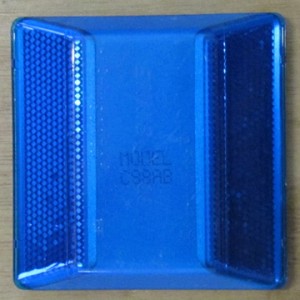 Finally,the blue markers are used all over the country to mark fire hydrant locations. These are placed either in the center of the road or at the edge. If a hydrant is at a corner then two markers are used. One for each street. Because of their universal application for hydrants it would be wise to avoid using the blue for any other application as this can confuse fire crews.
Finally,the blue markers are used all over the country to mark fire hydrant locations. These are placed either in the center of the road or at the edge. If a hydrant is at a corner then two markers are used. One for each street. Because of their universal application for hydrants it would be wise to avoid using the blue for any other application as this can confuse fire crews.
In private parking lots the blue, red and green markers generally serve the same purpose as on roads. For example, the blue would still always be used to mark a fire hydrant. The red may be used to highlight a fire lane or block off areas where cars are not to go. The green markers would do the opposite. White and yellow are often used in parking lots to designate cart return areas or to mark speed bumps. Road markers are normally not used in pedestrian areas due to the trip hazard they may cause. With this in mind markers are often used on factory floors to mark where pallets of material are to be stacked. In this case they are always out of the way of pedestrian traffic and are placed for fork lift traffic to see. The different color markers are available on this site and also on www.colebrothers.com .
